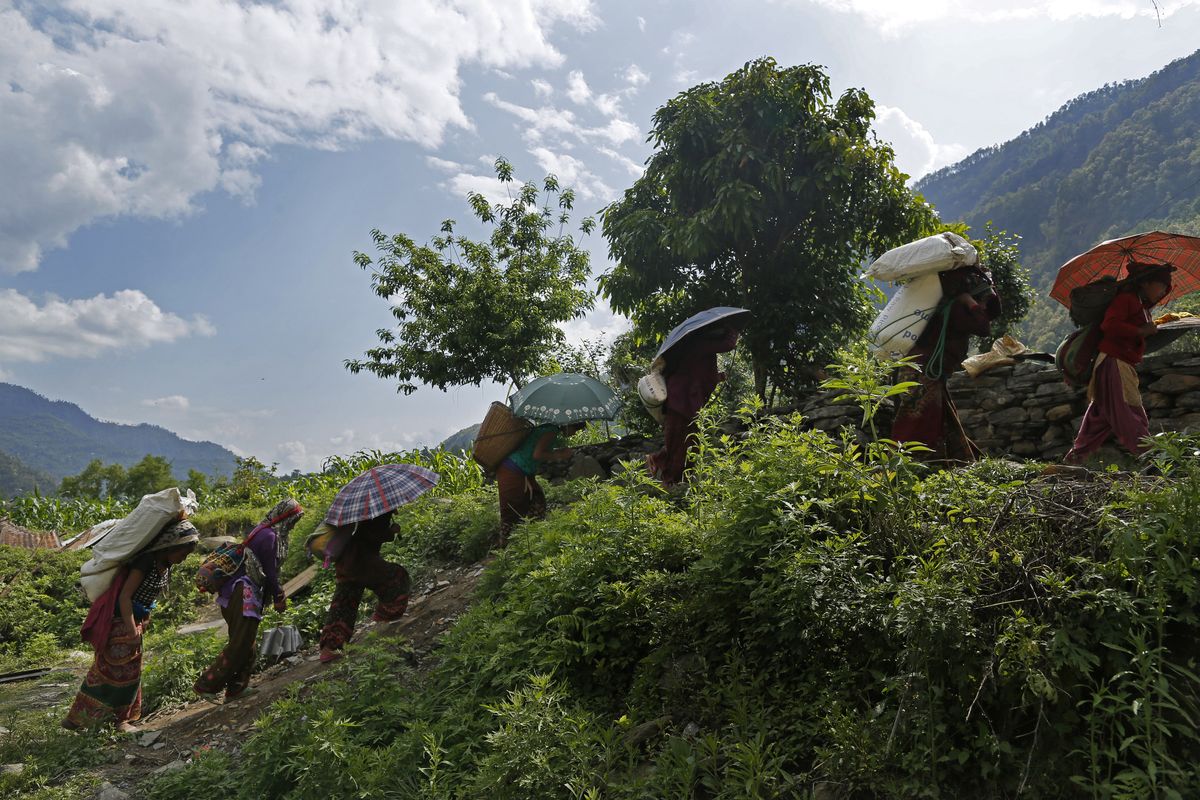Crews in Nepal find two survivors
Boy, woman were buried in building rubble for five days

KATHMANDU, Nepal – The 15-year-old boy had been buried alive under the rubble of this quake-stricken capital for five days, listening to bulldozers clearing mountains of debris, fearful the incessant aftershocks might finally collapse the darkened crevice he was trapped in.
And then, “all of the sudden I saw light,” Pempa Tamang said, recounting the moment Thursday he was pulled from a hole at the bottom of what was once a seven-story building in Kathmandu.
Tamang did not know whether he was alive or dead. “I thought I was hallucinating,” he said.
The improbable rescue was an uplifting moment in Nepal, which has been overwhelmed by death and destruction since the 7.8-magnitude earthquake hit Saturday. By late Thursday, the government said the toll from the tremor, the most powerful recorded here since 1934, had risen to 6,130 dead and 13,827 injured.
After night fell, police reported another dramatic rescue: A woman in her 20s, Krishna Devi Khadka, was pulled from a building in the same neighborhood as Tamang near Kathmandu’s main bus terminal, according to an officer who spoke on condition of anonymity because he wasn’t authorized to talk to the media.
“Life has become a struggle to survive. It gives us hope,” said Hans Raj Joshi, who watched Tamang’s rescue. “We thought they were only bringing out the dead. It’s hard to believe people are still alive.”
More than 70 aftershocks have been recorded in the Himalayan region by Indian scientists in the past five days, according to J.L. Gautam, the director of seismology at the Indian Meteorological Department in New Delhi.
Shortages of food and water and worry over the fate of relatives have triggered an exodus from the capital, prompting thousands to board buses provided by the government to their rural hometowns.
“I have to get home. It has already been so many days,” said Shanti Kumari, with her 7-year-old daughter, who was desperate to see family in her home village in eastern Nepal. “I want to get at least a night of peace.”
Although small shops have begun reopening, and the once ubiquitous tent cities have begun thinning out, an air of desperation remains. “We’re still feeling aftershocks. It still doesn’t feel safe,” said Prabhu Dutta, a 27-year-old banker from Kathmandu.
Some residents have begun returning to work, including at Dutta’s bank, but he said it was impossible to concentrate. “We roam around the office. We only have one topic of conversation: the earthquake.”
Tamang’s dark hair was disheveled, and he looked weak and tired but otherwise fine as he recounted his story in an Israeli field hospital.
Tamang said he was having lunch with a friend in the hotel where he worked when Saturday’s quake began at 11:56 a.m. As he ran downstairs, they shook. He saw walls cracking, ceilings caving in.
He was in the basement when “suddenly the building fell down. I thought I was about to die,” he told reporters. Tamang fainted, and when he regained consciousness, he could see little but darkness.
He was buried face down in a tiny crevice deep in the rubble. He was terrified.
For days, Tamang survived on two cans of ghee, or clarified butter. He rested his head on chunks of concrete and a broken piece of corrugated aluminum roof.
One Nepalese team had begun combing the rubble in Tamang’s neighborhood, a place they had found another survivor Monday. They cried out and knocked on broken concrete slabs, and then listened closely for any response.
Mostly there was silence. But when an officer named L. Bahadu Basnet, shouted “Is anyone there?” he was shocked to get a reply.
“Who is there? Brother, I am here!” Tamang shouted weakly back from a hole in the ground.
The team used a jack to help support the rectangular entrance, and Basnet took off his helmet, put on a headlamp, and crawled on his arms 10 feet inside, pushed in by his colleagues.
He could see Tamang wedged lying down in a crevice behind a motorcycle, and was shocked how responsive he was. “He thanked me when I first approached him,” Basnet said. “He told me his name, his address, and I gave him some water. I assured him we were near.”
It took a few hours to carefully clear the way for Tamang to be lifted out. Members of the U.S. Agency for International Development’s Disaster Assistance Response Team brought in equipment to help and lowered a pole-mounted rotatable camera into the hole, said one of the team’s members, Andrew Olvera.
Looking at a pair of huge, ripped concrete floors hanging precariously like curtains on the side of the destroyed building, just above the rescue site, Olvera said the operation was dangerous. But, “it’s risk versus gain. To save a human life, we’ll risk almost anything.”
At the Israeli field hospital, doctors X-rayed Tamang and injected him with glucose. Lt. Libby Weiss of the Israeli Defense Forces said he was dehydrated but lucid and “in remarkably good shape,” with no other injuries except scratches.
“It’s a miracle,” Weiss said. “I think it’s an amazing thing to see in the midst of all this calamity.”